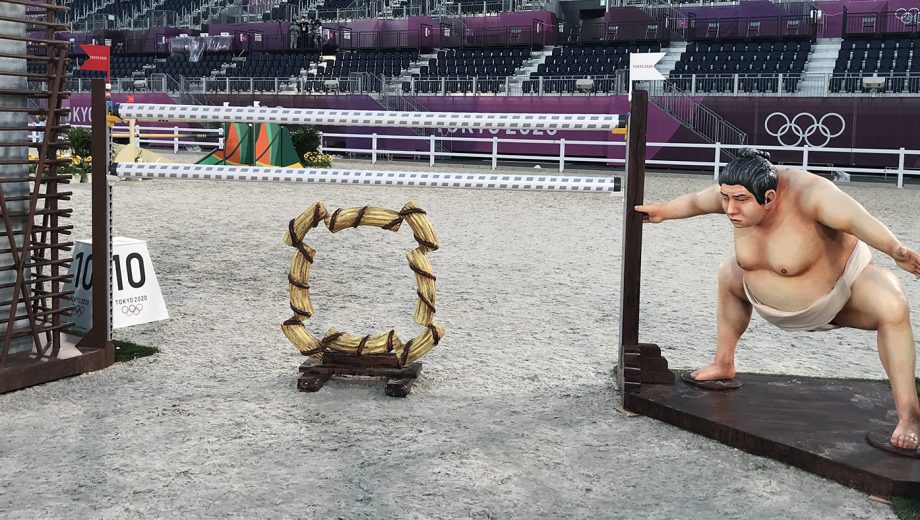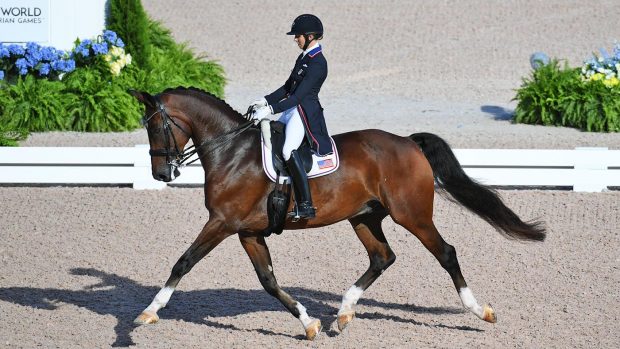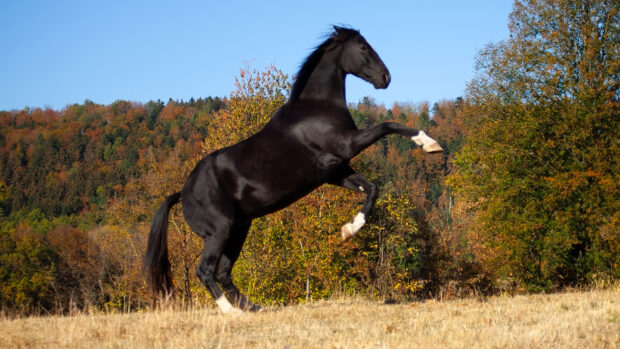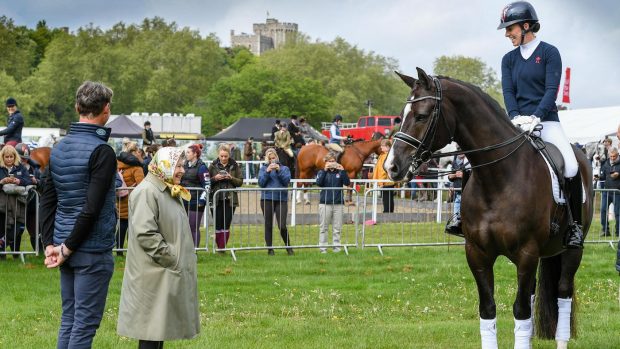The Olympic showjumping has just kicked off at the Tokyo Games, and the course for the individual qualifier, that takes place this evening, is a feast for the eyes. Representing various fascinating elements of Japanese culture and Olympic heritage, this course is a masterpiece, designed by Spain’s Santiago Verela.
The class will be under Table A, not against the clock, and there are 14 obstacles, with 17 jumping efforts. The time allowed is 86secs, with the time limit set as 178secs.
All combinations will jump this class, split into three groups, with all riders per nation (maximum three) riding in each group. The top 30 from today’s class will go forward to compete in tomorrow’s final, which will decide the individual medals. They will start that round on a score of zero and will not carry any penalties forward from today. The team competition takes place later this week on 6-7 August.
Take a stroll round the course…
1, Rio 2016
Height 1.52m; spread 1.45m

2. Tokyo Skyline
Height 1.55m
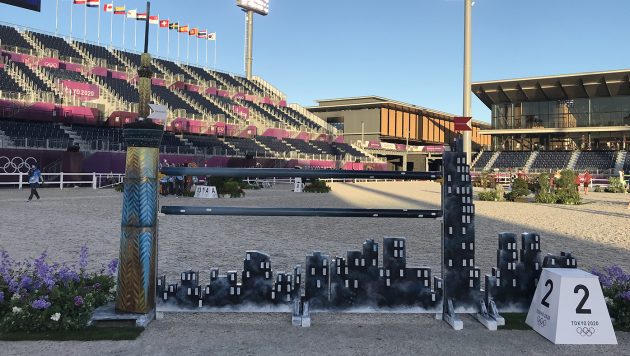
This jump features the Tokyo skyline, which has been eclipsed by the Sky Tree, Tokyo’s new communications tower, which is the highest structure in Japan at 634 metres, and the highest communications tower in the world.
3. Gold Repaired Broken Pottery
Height 1.52m; spread 1.60m
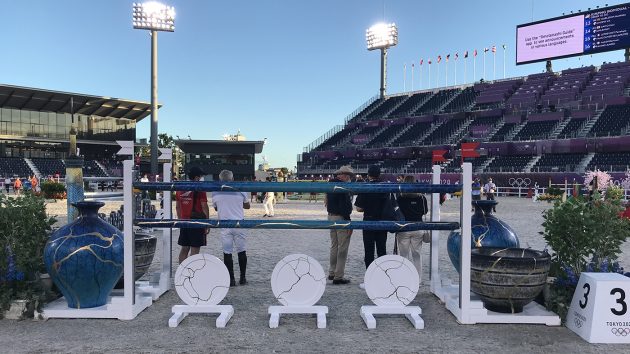
The “kintsugi” or “golden splice” is a traditional technique used in Japan, which dates of the second half of the 15th century. This technique gives a new life to the fragments of broken ceramics by joining them with a special enamel sprinkled with gold, silver or platinum, turning the different fractures into golden and visible scars. This turns its aesthetic essence into a more beautiful object than it was originally. It evokes the value of imperfection by making emphasis on its scars instead of concealing the lines of breakage, and by not hiding them, they become unique and win in beauty. It is one possible kind of life philosophy: when we are facing adversities and our errors, we must know how to recover, how to see the beauty in this imperfection (Japanese philosophy of Wabi-Sabi). We must also know how to lament only when we waste opportunities (the Mottainai sentiment), and most importantly, we must be able to accept changes.
4abc, Tanabata Festival
Part a – height 1.58m
Part b – height 1.58m
Part c – height 1.52m; spread 1.60m
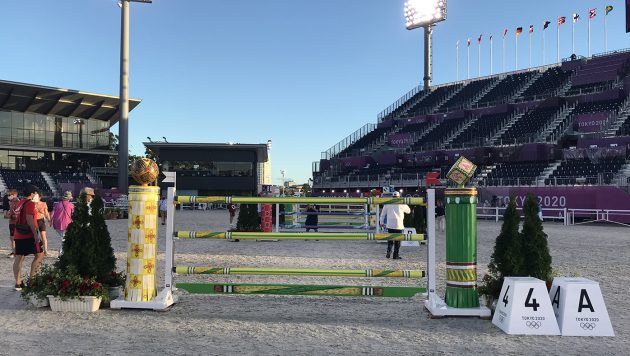
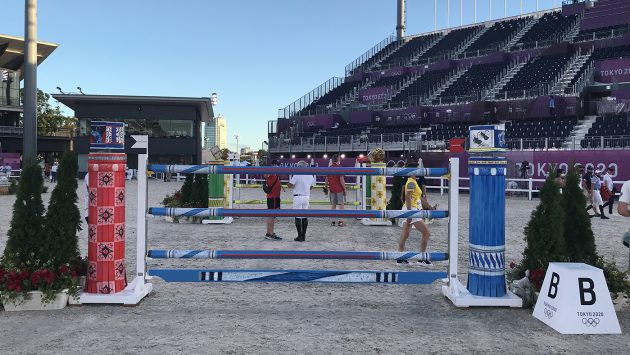
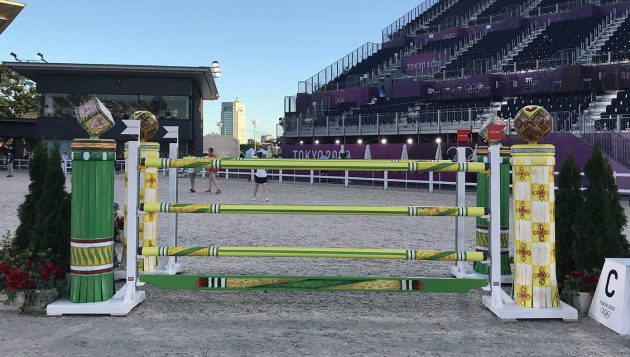
The three most important celebrations of the Tanabata festival are: Sendai Tanabata Matsuri, which takes place at the Miyagi prefecture; Shōhan Hiratsuka Tanabata Matsuri, which takes place at the Kanagawa prefecture; and lastly, the Anjō Tanabata Matsuri, which takes place at the Aichi prefecture. Tanabata is a national holiday in Japan, it’s considered one of their five traditional festivals, or gosekku (a fusion of Chinese and Japanese culture). Every year, on the seventh day of the seventh month of the lunar calendar (for some regions it is 7 July, for others, 7 August), Japanese people celebrate the annual encounter between Orihime (Vega) also known as the Weaver Girl and the mother of silk farming; and Hikoboshi (Altair) also known as the Cow Herder Star and the farmers’ messenger. The tradition states that once both meet they set up on a trip where they travel through the Milky Way to renew their love vows. Sendai’s (Miyagi) celebration is one of the most popular, and it is celebrated during the month of August. In Japan, this trip is commemorated by decorating trees with paper strips where people write their wishes, they are also known as tanzaku bands. Once written they are usually strapped up on bamboo branches, due to their stiffness which keeps them up straight without bending. According to the tradition, this helps the branches’ whisper reach the sky, and with it, everybody’s dreams.
5, Logo of the Tokyo 2020 Olympics
Height 1.60m; spread 2m
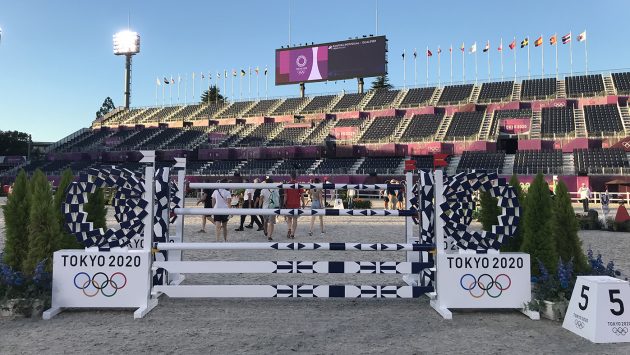
The harmonized chequered emblem, the logo for the Olympic Games, was designed by Japanese designer Asao Tokoro. Composed of three varieties of rectangular shapes, the design represents different countries, cultures and ways of thinking. It incorporates the message of “unity in diversity”. It also expresses that the Olympic and Paralympic Games seek to promote diversity as a platform to connect the world.
6, Gold Fish
Height 1.60m
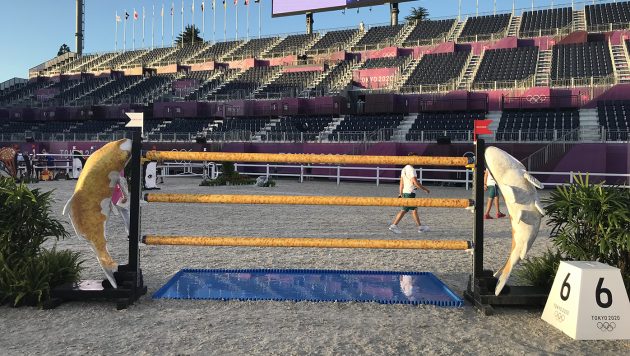
Goldfish (“kingyo” in Japanese) is a fish that is known for his grace while swimming in an aquarium. Simply watching a beautiful, lustrous goldfish in the water will make you feel relaxed. The established theory in Japan is that the goldfish arrived from China around 1502. At that time, goldfish were said to have been kept as a rare and strange pet of aristocrats and the wealthy. Thereafter, kingyo-sukui (goldfish scooping) became popular during the Edo period (1603 – 1868), leading to the sale of goldfish in towns. From then on until today, it has come to be a deeply familiar fish for Japanese people. There are more than 100 varieties of goldfish, including fish with high rarity value, focusing on the staple types seen in specialty shops. Goldfish were usually put in a tub or bucket and then viewed from the top. Today, however, it has become more popular to put a goldfish in a glass bowl or aquarium and then watch it from the side. You can see them everywhere nowadays, as they are not only kept inside houses anymore, but are also put in water tanks found in eating and drinking establishments, among other places. Goldfish are deeply familiar for Japanese people, they often appear as a motif in various artworks. For instance, you will see them in ukiyo-e (woodblock prints) made during the Edo period, as well as in the Art Aquarium that has become increasingly popular in recent years.
7, Nature, Landscape, and Animals: The Crane
Height 1.62m
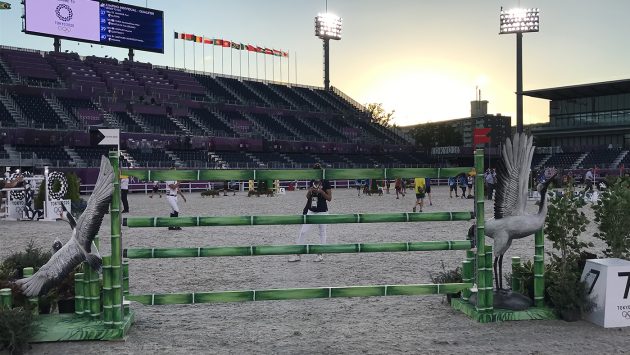
Outside of mythology, certain animals are considered national treasures of Japanese culture. The crane bird, venerated throughout all of Japan, stands out for its elegance, longevity and the aura of spirituality that surrounds it. Its agility and strong reaction to danger have been inspiration for hundreds of years in the martial arts. We can find it distributed along the island of Hokkaido, located in the north of Japan.
8, Equestrian Pictograms of the Olympics: Water Jump
Spread 3.90m

The appearance of the pictograms, as an iconic language, informative and systematic, is a phenomenon directly related to the history of the Olympic Games. The meeting of different languages and cultures, which is typical of the Olympic phenomenon, has been a stimulus for the development of visual languages that seek universal comprehension. The pictograms find their first applications in the organization of the Olympic Games, before becoming an indispensable language in large public spaces around the world. The first systematic design of pictograms, both of sports and of services was the one carried out for the Tokyo Games in 1964, with Masasa Katzumie, as artistic director, and Yoshio Yamashita as graphic realizer. It is considered as the first “dictionary” that allows the creation of a visual system of signs, of a language, of universal comprehension. Sports’ pictograms consist of elements of the human body and, in some cases, of elements representative of the instruments of the play and of the scenario, to represent the movement or the position which is estimated most representative of each sport.
9, Kimonos
Height 1.52m; spread 1.60m

The Japanese kimono is one of the world’s instantly recognizable traditional garments. The word kimono literally means “clothing”, and up until the mid 19th century it was the form of dress worn by everyone in Japan. This began to change slowly with the import of suits, dresses and other western fashions. Thanks to the popularity of ukiyo-e woodblock prints in the West at the beginning of the past century, the kimono-clad maiden became one of the quintessential images of Japan. Dressing up in the kimono and other accoutrements of the geisha or maiko is still one of the more popular activities for visiting tourists. There are different types of kimono for different occasions and seasons, including those worn by men. Other than those worn daily by some older people or performers of traditional arts, kimono is a much less common sight these days, but are still widely worn on special occasions such as weddings and graduation ceremonies. Lined kimono, is traditionally made out of silk but sometimes wool or synthetic fabrics, are worn during the cooler months. Light, cotton yukata is worn by men and women during the summer months and after bathing at onsen (hot spring resorts) and ryokan (traditional inns). Often, they are worn with geta, informal wooden footwear.
10, Sumo Tower and Wrestler (rikishi)
Height 1.62m

Sumo fighting is Japan’s national sport. It consists in a millenary way of fighting (it was invented over 1.300 years ago). The objective is for the fighters to throw their opponent either out of the dohyo or ring, or against the floor in order to win.
11, Senbazuru (Origami)
Height 1.53m; spread 1.65m
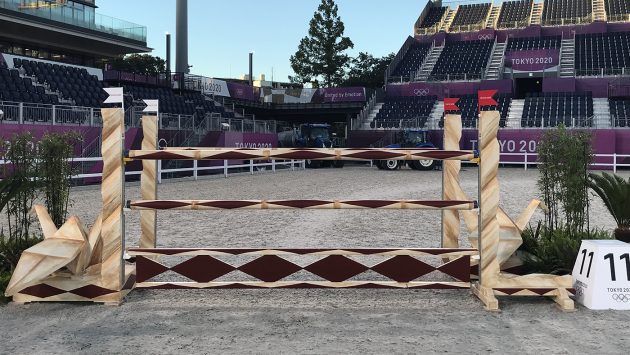
The word Origami (折り紙) stems from the Japanese terms Oru (折り, which stands for folding) and Kami (紙, which means paper). In Japanese culture Origami is considered a fundamental educational art, and has a great symbolic and cultural weight, as seen in the legend of the One Thousand Origami Cranes. Japanese temples and monuments are covered in colourful paper cranes held together by strings which is known as Senbazuru (千羽鶴). According to the tale, if you desire something with great passion and craft 1,000 paper cranes, the gods will grant your wish.
Sadako Sasaki resided in Hiroshima in 1945, 1.5 kilometres away from where the bomb was dropped. She developed Leukaemia and not diagnosed until 10 years after. She wished to cure herself from the disease and attempted to craft 1,000 origami cranes, but only managed to make 664. Her friends continued with the task and completed the 1,000 cranes hoping for no more wars. The children of Hiroshima placed a statue in her name, in which she can be seen holding a crane. The statue is located in the Hiroshima Peace Memorial Park, where every 6 August, Japan’s Peace Day, thousands of cranes arrive at Hiroshima from all over the world with hope that this peace message is transmitted all over the world.
12, The Nikko Mausoleum; Tochigi
Height 1.61m

The Shrines and Temples of Nikko form a single complex composed of one hundred three religious’ buildings within two Shinto shrines (The Tôshôgû and The Futarasan-jinja) and one Buddhist temple (The Rinnô-ji) located in an outstanding natural setting. The inscribed property is located inside the Tochigi Prefecture, in the northern part of Japan’s Kanto region. The mausoleum has been designated a National Treasure and UNESCO World Heritage Site in 1993.
13ab, Japanese Hairpins and Bow
Part a – height 1.53m; spread 1.60m
Part b – spread 1.60m
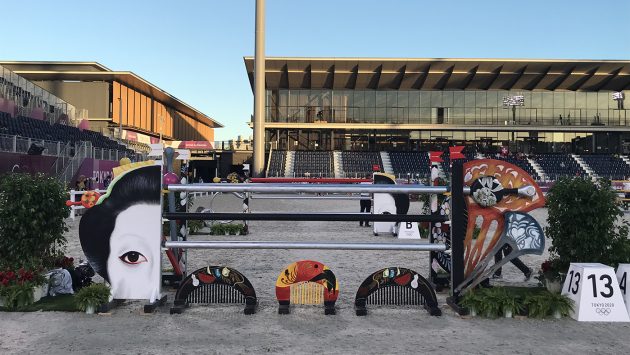
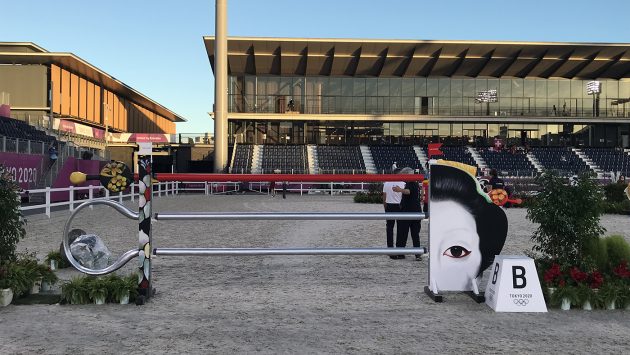
The Kanzashi (簪) are hair ornaments used in traditional Japanese hairstyles. They are fabricated from a wide range of materials such as lacquered wood, gold- and silver-plated metal, tortoiseshell and silk, and recently, plastic. Early bakelite kanzashi are highly valued as collectibles. There are several basic kanzashi styles that traditionally followed more complex hana (flower) and seasonal arrangements. Today these arrangements are only followed by maiko. Kanzashi were first used in Japan during the Jōmon period. During that time, a single thin rod or stick was considered to have mystical powers which could ward off evil spirits, so people would wear them in their hair. It came into wide use during the Edo period, when hairstyles became larger and more complicated, it required using a larger number of ornaments. Artisans began to produce more finely crafted products, including some hair ornaments that could be used as defensive weapons. During the latter part of the Edo period, the craftsmanship of kanzashi reached a high point, with many styles and designs being created.
14, Musical Instruments
Height 1.53m; spread 1.60m
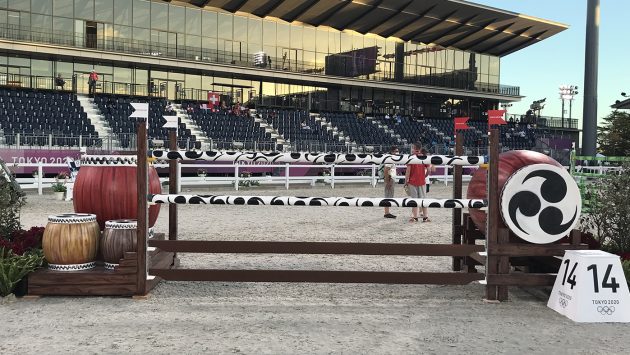
In Japan there is a wide variety of traditional music and instruments. The Taiko or “Big Japanese Drum”, played with wooden drumsticks called Bachi, is the most popular. In the religious sense in Shinto shrines and Buddhist temples, they are traditionally used as a means of transmission and meditation, to raise prayers and communicate with the gods. It is also one of the main characters in popular culture, in the different genres of traditional Japanese music, like the Gagaku and the Ohayashi, and we also see them in the different stage plays, which are played following the Kabuki and nō theatres. The drum, deeply rooted within the rural community, allowed to scare off evil spirits and pests that would damage the crops. In the war they were used to intimidate the opponents, raise the morale of the troops and order the army on the battlefield. In cities which were developed around the castle of a feudal lord, daimyō, it was used to mark the hours, and all the localities counted at least with a master craftsman dedicated to the elaboration of these instruments.
Olympic showjumping individual qualifier course plan

You might also be interested in:

How to watch Olympic showjumping live

Tokyo Olympics showjumping start list released: find out when the Brits jump in the individual qualifier

Britain win Olympic eventing team gold at Tokyo 2020

Tom McEwen wins Olympic eventing individual silver at Tokyo 2020

Subscribe to Horse & Hound magazine today – and enjoy unlimited website access all year round
Horse & Hound magazine, out every Thursday, is packed with all the latest news and reports, as well as interviews, specials, nostalgia, vet and training advice. Find how you can enjoy the magazine delivered to your door every week, plus options to upgrade your subscription to access our online service that brings you breaking news and reports as well as other benefits.

